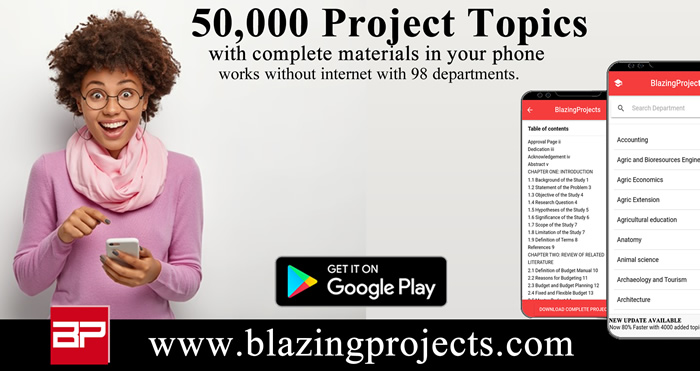Place Of Twitter As A Social Media As Interpersonal Communication Medium
Chapter 1
Introduction
1:1 Introduction
1:2 Background of the Study
1:3 Statements of Problems
1:4 Objectives of the Study
1:5 Research Question
1:6 Study of the Hypothesis
1:7 Significance of the Study
1:8 Justification of the Study
1:9 Scope of the Study
1:10 Definition of Terms
Chapter 2
Literature Review
2:0 Introduction
2:1 Conceptual Clarification
2:2 Theoretical Framework
2:3 Literatures on the Subject Matter
Chapter 3
Research Methodology
3:0 Area of Study
3:1 Source of Data
3:2 Sampling Techniques
3:3 Method Data Collection
3:4 Method of Data Analysis
3:5 Reliability of Instrument
3:6 Validity of Instrument
3:7 Limitations of the Study
Chapter 4
Data Analysis
4:0 Introduction
4:1 Finding of the Study
4:2 Discussion of the Study
4:3 Summary
Chapter 5
Summary, Conclusion and Recommendation
5:0 Summary of Findings
5:1 Conclusion
5:2 Recommendations
5:3 Proposal for Further Studies
Social media are computer-mediated technologies that facilitate the creation and sharing of information, ideas, career interests and other forms of expression via virtual communities and networks. The variety of stand-alone and built-in social media services currently available introduces challenges of definition; however, there are some common features:
Social media are interactive Web 2.0 Internet-based applications.
User-generated content, such as text posts or comments, digital photos or videos, and data generated through all online interactions, is the lifeblood of social media.
Users create service-specific profiles for the website or app that are designed and maintained by the social media organization.
Social media facilitate the development of online social networks by connecting a user’s profile with those of other individuals or groups.
Users typically access social media services via web-based technologies on desktop, computers, and laptops, or download services that offer social media functionality to their mobile devices (e.g., smartphones and tablet computers). When engaging with these services, users can create highly interactive platforms through which individuals, communities, and organizations can share, co-create, discuss, and modify user-generated content or pre-made content posted online. They “introduce substantial and pervasive changes to communication between organizations, communities, and individuals.” Social media changes the way individuals and large organizations communicate. These changes are the focus of the emerging fields of technoself studies. Social media differ from paper-based media (e.g., magazines and newspapers) or traditional electronic media such as TV broadcasting in many ways, including quality, reach, frequency, interactivity, usability, immediacy, and permanence. Social media outlets operate in a dialogic transmission system (many sources to many receivers). This is in contrast to traditional media which operates under a monologic transmission model (one source to many receivers), such as a paper newspaper which is delivered to many subscribers, or a radio station which broadcasts the same programs to an entire city. Some of the most popular social media websites are Baidu Tieba, Facebook (and its associated Facebook Messenger), Google+, Myspace, Instagram, LinkedIn, Pinterest, Snapchat, Tumblr, Twitter, Viber, VK, WeChat, Weibo, WhatsApp, and Wikia. These social media websites have more than 100,000,000 registered users.
Download The Complete Project Material Now!!
GET THE COMPLETE PROJECT»
Do you need help? Talk to us right now: (+234) 8111770269, 08111770269 (Call/WhatsApp). Email: [email protected]
IF YOU CAN’T FIND YOUR TOPIC, CLICK HERE TO HIRE A WRITER»
Disclaimer: This PDF Material Content is Developed by the copyright owner to Serve as a RESEARCH GUIDE for Students to Conduct Academic Research. You are allowed to use the original PDF Research Material Guide you will receive in the following ways: 1. As a source for additional understanding of the project topic. 2. As a source for ideas for you own academic research work (if properly referenced). 3. For PROPER paraphrasing ( see your school definition of plagiarism and acceptable paraphrase). 4. Direct citing ( if referenced properly). Thank you so much for your respect for the authors copyright. Do you need help? Talk to us right now: (+234) 8111770269, 08111770269 (Call/WhatsApp). Email: [email protected]
Related Current Research Articles
Purchase Detail
Hello, we’re glad you stopped by, you can download the complete project materials to this project with Abstract, Chapters 1 – 5, References and Appendix (Questionaire, Charts, etc) for N4000 ($15) only, To pay with Paypal, Bitcoin or Ethereum; please click here to chat us up via Whatsapp.
You can also call 08111770269 or +2348059541956 to place an order or use the whatsapp button below to chat us up.
Bank details are stated below.
Bank: UBA
Account No: 1021412898
Account Name: Starnet Innovations Limited
The Blazingprojects Mobile App

Download and install the Blazingprojects Mobile App from Google Play to enjoy over 50,000 project topics and materials from 73 departments, completely offline (no internet needed) with the project topics updated Monthly, click here to install.
Recent Comments